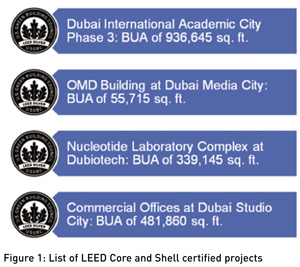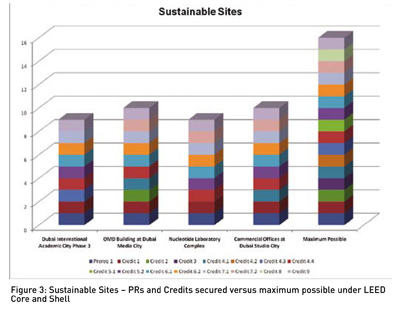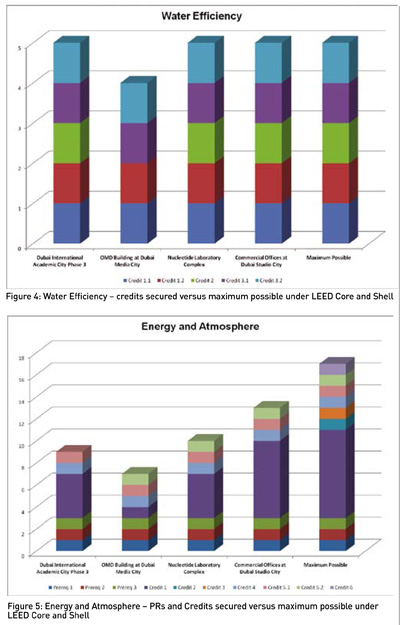In this two-part series, Sougata Nandi analyses four LEED-certified projects in Dubai as benchmarks and assesses how far LEED certification credits are applicable and viable in the region.
In this two-part series, Sougata Nandi analyses four LEED-certified projects in Dubai as benchmarks and assesses how far LEED certification credits are applicable and viable in the region.
Much has been said, debated and theorised about green building certification in the UAE. The entire concept of green building certification and, more specifically, applying established green building rating systems, in general, and LEED, in particular, to certify buildings in the UAE, was opposed aggressively by the industry during the period 2005-2008. Even today, there are reservations about these “imported” rating systems, although UAE itself already has more than 40 LEED-certified projects. The reasons for misgivings is not far to seek. Here is a list of key objections:
August 2006 was the time when we deployed the Sustainable Development Policy at TECOM Investments, the knowledge economy developer in Dubai and the owner of 11 Business Parks. These are: Dubai Internet City, Dubai Media City, Dubai Knowledge Village, Dubai International Academic City, Dubai Outsource Zone, Dubai Studio City, International Media Production Zone, Dubai Biotechnology and Research Park, Enpark, Dubai Healthcare City and Dubai Industrial City. The key objectives of the policy were to construct all new buildings as LEED Silver-certified at the minimum, reduce electricity and water costs and implement sustainable procurement.
This article analyses four LEED-certified projects in Dubai and assesses what can and cannot be done in this part of the world, as also the commercial implications of LEED projects. Understanding of this analysis requires prior knowledge of the LEED rating system for green buildings. This is not an explanation of LEED certification mechanism but a consolidation of four projects used as case studies to demonstrate the applicability of LEED in this region.
To put it succinctly, it must be remembered that LEED certification, or for that matter, any green building certification mechanism is an adoption of the “best practices” in design and development – elements that should be considered by default for developments that aspire to be responsible to the environment, to the economy and to the people inside and outside the buildings.
ANALYSIS FRAMEWORK
The Sustainable Energy and Environment Division’s (SEED) LEED certification work at TECOM is largely focused on Core and Shell type of developments. In 2009, we delivered the first LEED Platinum Commercial Interior – the TECOM Management Office located out of Dubai Internet City’s Building Number 4. At 10,000 square feet of built-up space, the prime driver for us to have this space certified was to demonstrate our commitment to the green building programme and to lead by the highest example possible.
 Beginning April 2009, TECOM has delivered four LEED C&S-certified buildings – the sixth, seventh, 12th and 13th LEED-certified projects in the region. This is in addition to TECOM Management Office’s LEED Platinum Commercial Interior, which was also the fifth LEED-certified project in the region. Thus, in a manner of speaking, SEED’s green building programme consolidated the trend of green building certification in the region.
Beginning April 2009, TECOM has delivered four LEED C&S-certified buildings – the sixth, seventh, 12th and 13th LEED-certified projects in the region. This is in addition to TECOM Management Office’s LEED Platinum Commercial Interior, which was also the fifth LEED-certified project in the region. Thus, in a manner of speaking, SEED’s green building programme consolidated the trend of green building certification in the region.
As part of our ongoing mandate, SEED is committed to generating awareness on sustainable development in the region, and has consciously shared technical and financial information on the LEED projects developed at TECOM. While data from the four projects do not necessarily constitute a highly reliable statistical stock, it nevertheless demonstrates certain pointers, which may guide developers and sustainability practitioners to make the LEED certification process more efficient, cost-saving and, most importantly, help focus on the right areas that are possible and relevant. Towards this end, this treatise is focused on information from four LEED Core and Shell-certified projects listed in Figure 1.
The LEED Gold Commercial offices at Dubai Studio City secured the Sustainable GCC Project of the Year in 2010 at the MEP Awards.
Except for the OMD Building, all the other three buildings are designed to be served by district cooling systems, with OMD Building having its own air-cooled chillers. While Nucleotide Laboratory Complex is designed to have 100% fresh air (being a laboratory), the other three projects have standard HVAC systems for office complexes.
This analysis will look at the credits that were achieved at these projects, review the project financials and will come to certain conclusions at the end.
The analysis assumes that the readers are familiar with LEED and its various rating frameworks. Those unfamiliar with the LEED for Core and Shell certification programme are advised to visit www.usgbc.org for detailed information on how the rating system works.
PERFORMANCE EVALUATION OF FOUR LEED CORE AND SHELL PROJECTS IN DUBAI
The summary LEED C&S scorecard for all four projects is listed in Figure 2 below. It needs to be pointed out that the prime driver for SEED’s work is to reduce operating and/or capital expenditure for the organisation. Having our new projects LEED certified assists in reaching these objectives. The second key issue is that SEED is focused on small shifts at a time. Thus, the objective for all our projects is to secure a LEED Silver level of certification as a minimum, as opposed to LEED Platinum or Living Buildings. However, if an opportunity were to present itself to secure a LEED Gold or a higher level of certification, it would be captured, as in the case of commercial offices at Dubai Studio City. This target may evolve and become more mature over a period of time.
 The summary scorecard demonstrates that the number of points secured by these four projects range from 29 to 36 – a narrow band of only seven points or 10% variation on a scale, where 61 is the maximum. Commercial offices at Dubai Studio City have outscored the next closest project by four points, of which three have come from “Optimise Energy Performance” credit. Our focus, thus, is quite evident.
The summary scorecard demonstrates that the number of points secured by these four projects range from 29 to 36 – a narrow band of only seven points or 10% variation on a scale, where 61 is the maximum. Commercial offices at Dubai Studio City have outscored the next closest project by four points, of which three have come from “Optimise Energy Performance” credit. Our focus, thus, is quite evident.
The percentages listed within each category in the scorecard indicate the success rate of the credits within the particular category. Fifty-seven per cent for sustainable sites indicates that on an average (for these four projects), 57% of the credits within this category have been successfully secured. Similarly, the success rates are 95% for Water Efficiency, 48% for Energy and Atmosphere, 18% for Materials and Resources, 52% for Indoor Environmental Quality and 90% for Innovation and Design Process.
Overall, these four projects have secured 53% of the total credits successfully, in addition to fulfilling the pre-requisites. Projects planning to pursue LEED C&S certification may want to utilise this number of 53% as a reference pointer.
The following sections address the details of each of the six individual categories for the LEED C&S certification, namely Sustainable Sites, Water Efficiency, Energy and Atmosphere, Materials and Resources, Indoor Environmental Quality and Innovation and Design Process.
SUSTAINABLE SITES
For the purpose of quantifying performance, the pre-requisites have also been allocated a point each for each category. As it is shown in Figure 3, this category produces an average performance. This category is typified by certain credits that are simple and could already be available by default.
Credits like site selection, development density and public transportation access are examples of such types of credits. Brownfield re-development is impossible to achieve, not only in Dubai but also anywhere in the world, unless the project is situated at an environmentally damaged or sensitive site. This is rare for projects in Dubai.
Credits like bicycle storage and showering facilities are irrelevant here, not just because of the weather but also because of the nature of our developments, which tend not to have safe and secure bicycling roads leading up to them.
 One of the technically easiest credits to achieve is the Light Pollution Reduction credit. Unfortunately, this does not work on projects here due to a tilt towards bright lighting requirement attributed to brand image. Finally, a very tricky credit to decide on is the parking capacity. Given the penchant for an automobile-driving culture and a public transportation system that has just begun taking shape, applying this credit on to a project might constitute a commercial risk, and is sometimes perceived as impacting the viability of a project.
One of the technically easiest credits to achieve is the Light Pollution Reduction credit. Unfortunately, this does not work on projects here due to a tilt towards bright lighting requirement attributed to brand image. Finally, a very tricky credit to decide on is the parking capacity. Given the penchant for an automobile-driving culture and a public transportation system that has just begun taking shape, applying this credit on to a project might constitute a commercial risk, and is sometimes perceived as impacting the viability of a project.
Non-roof heat island effect credit is easily achieved, as by default, three of the projects have their car parks in the basement and all surface parking is shaded. Dubai International Academic City Phase Three was the first LEED project in the region to provide dedicated car parking spots for energy efficient/green vehicles and, thus, is the only one of the four projects to secure this credit.
WATER EFFICIENCY
As it is evident from Figure 4 below, assigning priority to credits in this category, is a no-brainer. Successful realisation of credits in this category has all-round benefits to all stakeholders – the developer, occupants, utility companies, municipalities, environment and future generations. Most importantly, from the viewpoint of a commercially driven organisation, this means significant operating cost savings for the lifetime of the project.
This category is also most easy to achieve, as can be noted from Figure 4, which shows that three projects achieved five out of five and one project secured four out of five credits.
For our LEED projects, water efficiency is a top priority item, as it has tremendous cost-saving implications, not only in terms of purchasing of potable water but also in relation to disposing of wastewater on some of our projects, which do not have a municipal sewage connection and, thus, have to rely on sewage tankers.
Sewage tanker rates had crossed AED1,000 for a 10,000-gallon tanker during the peak of the economic boom in Dubai. Thus, reducing, or perhaps, completely eliminating sewage tanker requirement saves much more money than reduction of potable water purchase.
What Figure 4 does not display is that, it is highly possible to perform over and beyond the expectations in both wastewater treatment and reduction in potable water consumption. However, these achievements get captured in Innovation and Design Process category.
ENERGY AND ATMOSPHERE
The presence of the word “atmosphere” in the name of the category clearly underscores the very close link between energy and environment. The continuous and incremental damage that all development is bound to cause can be limited through energy efficiency, green power and appropriate refrigerant usages.
While most of the credits within this category will be achieved to varying degrees of success through appropriate application of time, effort and money, the two credits of On Site Renewable Energy and Green Power are highly unlikely to be achieved in Dubai, even if no constraints were to be levied on budgets. This is so for two very simple reasons: (1) green power is not available through the grid here, and (2) due to significantly high annual energy consumptions in buildings here, on-site renewable energy (typically solar photovoltaic or solar water heating) find it difficult to meet the one per cent threshold criterion.
Enhanced Commissioning is a credit that is rarely going to be pursued as a norm, simply because of the fact that it is likely to cost more than regular commissioning. And given the lack of an obvious evident return in financial terms, is generally not pushed for. The other challenge with this credit is an apparent lack of expertise in conforming to the prescribed LEED requirements.
Thus, the prime focus within this category gravitates towards energy-efficient design, since these are achievable, and even if these may require additional time, effort and money, they will definitely have significant positive financial returns for the life cycle of the project.
In mature construction markets around the world, achieving more credits in energy efficiency usually requires additional capital cost. This occurs due to more costly but energy-efficient lighting technologies, enhanced insulation levels, significantly higher-performing glazing, highly energy-efficient chillers and chilled water systems. However, in the UAE, buildings are generally over-designed for both lighting and air conditioning in order to allow for safety factors. For example:
While ASHRAE 90.1 may recommend an LPD (Lighting Power Density) of 1.3 W/square feet for office, it is not uncommon to find designs with 3.0 W/square feet.
While some projects function adequately with an installed HVAC capacity of around 400 square feet/TR, there are many over-designed projects that have installed capacity of less than 200 square feet/TR.
In such situations, applying green building design criterion actually helps eliminate over-design and encourages right-sizing. This, in turn, reduces capital expenditure, sometimes significantly (in the range of several hundred thousand US dollars). Most often, this more than offsets any additional costs incurred in selection of more energy-efficient chillers or LED lights, for example.
In essence, this scenario eliminates the constraints of premium prices required to build green.
The writer is the Executive Director, Asset Management & Sustainable Development, TECOM Business Parks Operations. He can be contacted at Sougata.nandi@tecom.ae/ Sougatan@eim.ae
To be continued in the next issue …
Copyright © 2006-2025 - CPI Industry. All rights reserved.